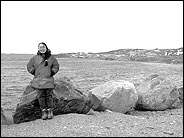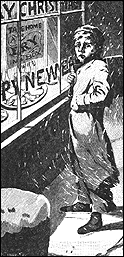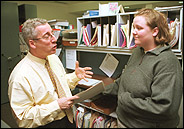on campus
Good news for northern ears
 |
|
| Are northern ears any different from the southern variety? Yes, as it turns out, and in a way that causes loss of hearing in 20% to 25% of Inuit schoolchildren, a rate 15 times that of their southern counterparts.
The problem is otitis media, a middle ear infection that causes deafness when left untreated. McGill, initially through the School of Communication Disorders and, since 1992, at the Montreal Childrens' Hospital, has been working for 16 years to alleviate the problem. Northern Ears, a video for nurses and community health workers in the north, is the latest effort.
MCH audiologist Hannah Ayukawa first conceived of the idea for the film after receiving funding from the federal government's Brighter Futures Program in the North to purchase a video-otoscope. The tool allows Ayukawa, during her five to six annual trips to the Quebec portion of Nunavik, to see the inside of the childrens' ears and to record the image on videotape.
Some of the images of the inner ear are on the 15-minute (in French or English —16 minutes in Inuttitut) video, which also reviews the anatomy of the ear, the use of otoscopes and the development and prevention of otitis media. Ayukawa's hope is that with preventive measures — such as good nutrition, encouraging people not to smoke inside and more housing in order to reduce overcrowding —and proper and early diagnosis of the disease, hearing loss may be avoided.
"When, for instance, a baby has three infections by six months, this is a warning sign of chronic otitis and we say to doctors: 'Try to treat these very aggressively [with antibiotics]'," says Ayukawa, who has been going up north for 10 years. She notes that it is only those Inuit born since 1950 that are vulnerable to otitis media. Older Inuit weren't affected because they had little contact with "white diseases."
Work study program receives top marks
Raves for McGill's Work Study Program are spreading beyond the University's Roddick Gates. ISO-Jeunes, a division of Human Resources Development Canada that campaigns for increased youth employment, has distinguished McGill's popular student job program with an award of recognition.
The Work Study Program received its ISO-Jeunes distinction during a November 22 ceremony at McGill's Faculty Club. Eight other employers, ranging from Tim Hortons to La Chambre de commerce et d'industries de Laval, were also recognized with ISO-Jeunes awards.
ISO-Jeunes, which stands for innover, sensibiliser, et oser (innovate, raise awareness and take a risk), was created in 1998 to lobby employers into hiring more young people into career advancing positions. The Work Study Program received top marks for providing good jobs for students in financial need.
This year alone, some 1,100 students applied for about 700 Work Study jobs, which range from clerical to lab assistant positions. Students are keen about getting hired through the Work Study Program, since its positions are always based on campus, can offer career-related experience and often pay over minimum wage — up to nearly $12 an hour.
Since its 1992 launch, the program has quickly become one of the first places faculties and departments turn to when looking for part-time employees. Not just because it offers a pool of competent workers, but also because the service refunds 50 per cent of student salaries or up to $1,000 per semester.
Judy Stymest, director of McGill's Student Aid Office, says the ISO-Jeunes distinction demonstrates how valuable the Work Study Program has become. "It's a great program that creates a win-win situation for both students and the University," she says, noting the service is especially useful for international students who aren't eligible for work permits. "For them, the Work Study Program is often the only way they can obtain work."
For more information on McGill's Work Study program, please call work study administrator Sandy Chopko at (514) 398-2551 or consult www.IS.mcgill.ca/STUDENTAID/WORKSTUDY/. January 8, 2001, is the deadline for winter session applications for work study jobs.
Helping hungry students
 |
|
When we think of Christmas hampers, McGill students don't exactly come to mind. Yet, for the third year in a row, Food for Thought, a project established originally by a few social work students aware of hungry students on campus, is in operation, giving food or food vouchers every Friday afternoon.
This year is a particular challenge in terms of donations of food because of the fire that put the Park Avenue Provigo temporarily out of commission. That store was a principal donor of food. Students in Douglas Hall have helped fill the gap, says FFT coordinator Doris Kim, by initiating food and donation drives among their peers. Kim, a graduate student in nursing, notes that donations of more than $20 are tax deductible.
At the moment, Kim is organizing the "Holiday Hamper" program whereby students and their families in need will receive a basket of canned food. She is hoping to have the means to include a turkey and fresh fruits and vegetables as well as Christmas goodies like candles and chocolate.
"We're asking for donations by December 15," she says, noting that donors may mail a cheque, addressed to the Yellow Door, or may phone the community volunteer and cultural centre to have goods picked up. There are also food donation boxes in the faculties of management, dentistry, and education, and at Student Health Services, Thompson House and Martlet House. The hampers will be distributed on December 16 and Kim will need the help of volunteers, especially drivers with access to a car.
Last year, 25 hampers were given, mostly to international students. This year, since the Friday food distribution began in October, Kim has seen mostly graduate students. "Hunger is more prevalent in graduate students than in undergrads who tend to have family support," she says.
Food for Thought's mailing address is The Yellow Door, 3625 Aylmer St., Montreal H2X 2C3, and the phone number: 398-6243.
Awarding outstanding educators in medicine
 |
|
Even though the Faculty of Medicine has many of its own teaching awards, Dr. Yvonne Steinert felt more could be done to recognize "the invaluable contribution" to medical education of many of the faculty's 2,000-plus members.
"There were very few faculty-wide awards and we wanted to go beyond teaching, to recognize educational leadership and innovation, faculty development and research and scholarly work in education," explains the associate dean of medicine (faculty development).
So, three years ago, she helped launch the "Faculty Honour List for Educational Excellence." Nominated by their peers, supervisors or students, those honoured must have been on faculty for at least five years in a full-time or part-time capacity.
"This award is different from the others because it's not limited to one individual," says Steinert. "There are so many who are deserving."
One of this year's honourees is Dr. Pierre-Paul Tellier, director of undergraduate education in the Department of Family Medicine and of Student Health Services. Tellier's specialty is in the psycho-social aspects of family medicine, in such spheres as adolescent health, gay and lesbian health and "party" drugs.
One of Tellier's innovations involved developing a method of teaching second year medical students how to conduct a pelvic examination using "patient-teachers," women who are trained and paid to instruct the students on how to conduct an exam in a respectful way and to give students their feedback.
Others recently named to the honours list were oncology professor Eduardo Franco, psychiatry professor Daniel Frank, anatomy and cell biology professor Dennis Osmond, surgery professor Yoshinori Taguchi, family medicine professor Mark Yaffe and Dr.Jean-François Yale from the McGill Nutrition and Food Science Centre.
Winners are fêted at an annual symposium on education in the health sciences where they share their methods and inspirations with colleagues.
Steinert says now is the time to nominate new candidates for the 2001 Faculty Honour List.
For more information on the honour list and how to nominate a candidate, see: www.med.mcgill.ca/facdev/fachonourlist.htm.
Kudos
Professor Albert Aguayo, from the Department of Neurology and Neurosurgery, will become the secretary-general of the International Brain Research Organization next month. The organization has more than 50,000 members worldwide. Aguayo also recently earned the Christopher Reeve Research Medal for his groundbreaking research on spinal cord injuries. Aguayo proved that the central nervous system was capable of regeneration. The prize, worth $25,000, was awarded at a black tie event hosted by actors Liam Neeson and Natasha Richardson.
Professor Guy Rouleau, from the Departments of Medicine, Neurology and Neurosurgery, Human Genetics and Psychiatry, has earned one of the country's most prestigious prizes for research in the medical sciences — the Canadian Institutes of Health Research's Michael Smith Award for Excellence. Rouleau is internationally recognized for his contributions to mapping and isolating genes of neurological and psychiatric disorders.
Ms. Kimberly Bothi, a student in the Department of Agricultural and Biosystems Engineering, was the top winner in the American Society of Agricultural Engineers' K.K. Barnes Student Paper Competition. Her paper was entitled Advanced Remediation Technologies. Bothi was fêted at the ASAE's international meeting.

